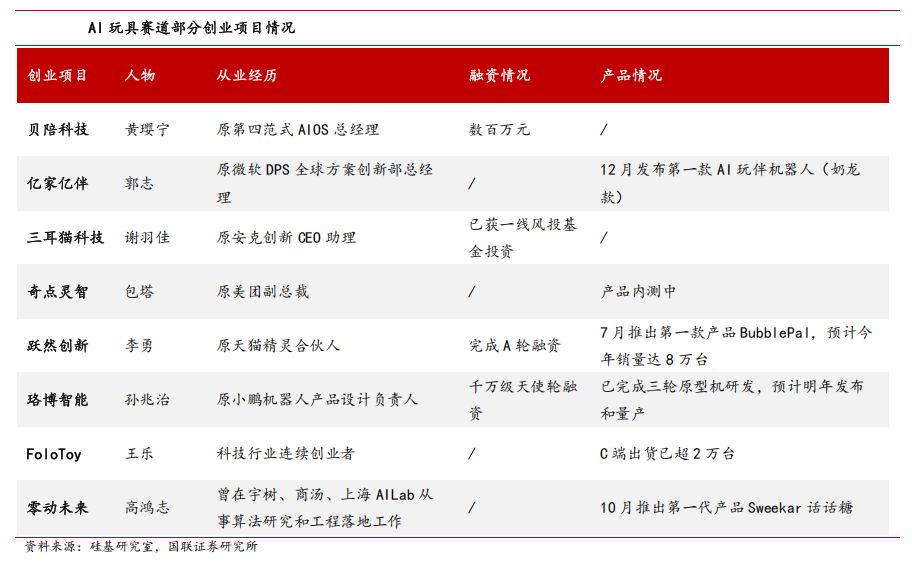AI Toy Market Booms: Why Premiums Up to 10x and Rapid Expansion?
![]() 04/27 2025
04/27 2025
![]() 759
759
As the wind of AI sweeps through the toy industry, a vast blue ocean market is being tapped.
Ordinary toys, once equipped with AI functions, not only see their prices multiply but also witness soaring sales. Industry insiders reveal that large models can elevate the price of regular toys by over 10 times, with toys originally priced at 9.9 yuan selling for up to 99 yuan after AI modifications. In Shenzhen, an innovative tech company achieved a live streaming sales volume of 520,000 yuan for AI toys in just one day.
Branded products such as Casio's AI pet Moflin, Tesla's robot toy Tesla Bot Action Figure, Shifeng Culture's new-generation AI toy "AI Magic Star," Mengchong's intelligent pet robot Ropet, and ByteDance's AI companion doll "Xianyanbao" are favored by consumers. Some even experience price surges in the second-hand market.
Recognizing the vast potential, many executives from domestic giants have entered and increased investment in the AI toy sector, including the former vice president of Meituan, the former partner of Tmall Genie, and the former head of product design for Xiaopeng Robotics. Some products have already garnered initial market recognition—for instance, Haivivi, founded by Li Yong, a former partner of Tmall Genie, launched the AI toy pendant "BubblePal" in July 2024. As of March 2025, sales of this product on the Douyin platform alone have surpassed 20 million yuan.

Image source: Guolian Securities
According to data from consulting firm IMARC Group, the AI toy market size reached $18.1 billion in 2024 and is projected to grow to $60 billion globally by 2033, with the Asian market leading the charge. Riding on the wave of AI toy popularity, this article briefly analyzes the core drivers behind this market growth from the perspective of the smart internet industry, illustrating the industrial logic and evolution path of this emerging market.
Chip and Module Manufacturers Rush to Lay the Groundwork, Lowering the Barrier to AI Toy Development
Firstly, the explosion of the AI toy market is inextricably linked to the technological innovation and ecological support of upstream chip and module manufacturers.
Over the past year, multiple chip manufacturers have successively announced AI toy solutions, including Espressif Systems, Rockchip, Allwinner Technology, Actions Semiconductor, Broadcom, Taixin, and Airoha Technology. For example, ByteDance's AI toy "Xianyanbao" utilizes Espressif's ESP32 chip. This chip integrates 2.4GHz Wi-Fi and Bluetooth 5 (LE), equipped with an Xtensa® 32-bit LX7 dual-core processor running at up to 240MHz, providing robust processing capabilities to handle complex computing tasks and multi-task parallel processing requirements. Additionally, ESP32-S3 includes vector instructions for accelerating neural network computations and signal processing. AI developers can leverage these vector instructions through the ESP-DSP and ESP-NN libraries to achieve high-performance applications such as image recognition, voice wake-up, and recognition.
The Talking Tom Emotional Companion Robot is equipped with Allwinner Technology's R128 highly integrated wireless audio chip, featuring a RISC-V XuanTie C906+Arm CortexM33 dual-core architecture with powerful computing capabilities. It also supports WLAN 2.4G+Bluetooth V5.0 dual wireless communication protocols, enabling various network applications and ensuring stable network connectivity.
Following closely, module manufacturers have also rolled out integrated solutions. In January of this year, Quectel announced an AI smart solution tailored for the toy market. This solution leverages Quectel's robust communication capabilities in wireless communication solutions and full-link audio algorithms, deeply integrating advanced AI technologies and extensive data resources from large models like Doubao, achieving seamless connection between smart toys and cloud AI capabilities. In February, Quectel further announced a comprehensive improvement and upgrade to its overall AI toy solution, which deeply integrates the AI large model capabilities of Volcano Engine, integrating wireless communication modules, audio algorithms, IoT platforms, and billing management platforms, providing a one-stop service for the intelligent upgrade of toys from hardware, algorithms to platforms.
Also in January of this year, Fibocom launched an AI toy large model solution deeply integrated with AI large models such as Doubao, equipped with Fibocom's Cat.1 module, assisting in the AI upgrade of smart toys. This solution enables audio, video, and image transmission, speech recognition, natural language processing, and machine learning without the need for an external MCU. Through anthropomorphic/animal-like/IP-like forms, it interacts with users through multiple dimensions of sight, hearing, and touch, opening up new avenues for the innovative development of AI toys. In February, Fibocom announced that its AI toy solution accesses the DeepSeek open-source model through Volcano Engine, fulfilling the needs of AI toys in multi-modal interaction, natural language processing, sentiment analysis, and educational functions.
Whether it's solutions launched by chip or module manufacturers, they all aim to help toy manufacturers lower the threshold for developing and launching AI toys. Business opportunities often come and go swiftly, and the longevity of the AI toy trend is uncertain. For many traditional small and medium-sized toy manufacturers, they lack solid intelligent capabilities. However, one-stop solutions enable them to focus on exploring niche market needs, quickly realize product intelligence, and bring new AI toys to market, seizing the initiative. Simultaneously, these solutions promote the standardization of the supply chain, further reducing the hardware costs of AI toys and achieving considerable gross profit margins.
The Rise of Edge AI Enables Terminal Hardware to Achieve Better Intelligence at Lower Costs
The emergence of large models has brought about a qualitative leap in the intelligence of AI toys. Unlike the limited "preset answer" interactions of the past, today's AI toys are beginning to possess advanced cognitive functions such as natural language generation, knowledge graph invocation, and multi-turn dialogue.
However, previously, AI represented by large models faced numerous challenges in edge and terminal inference applications. Algorithms represented by DeepSeek-R1, through efficient distillation technology, migrate the inference capabilities of large models to smaller, more efficient versions. This breakthrough enables its smaller version to maintain excellent performance while significantly reducing model size and computational resource requirements, making it an ideal choice for edge deployment, thereby driving the explosion of edge AI.
The reason why smart hardware struggled to sell in the past is that it failed to adequately address a core question: "Why should consumers pay for you?" For hardware manufacturers, the art of balancing technology and business lies in providing consumers with a better intelligent experience at a lower cost. From this perspective, edge AI, fueled by DeepSeek, lowers the threshold for hardware manufacturers to deploy high-performance AI at the edge through technological innovation and ecological optimization. Toys, as a category, have limited volumes, and consumers are relatively price-sensitive towards them, making them another ideal carrier for the implementation of edge AI.
At the solution level—as mentioned earlier, Espressif's ESP32 chip supports the local running of lightweight AI models (such as TensorFlowLiteMicro), enabling complex tasks like voice wake-up (<100ms response) and face recognition (ESP-WHO library). Airoha Technology's "Wutong" second-generation series chip AC791N supports tri-mode coexistence of Wi-Fi + Classic Bluetooth 2.1 + Bluetooth BLE5.0, with a built-in matrix vector accelerator that supports lightweight AI neural networks and can also implant more complex AI algorithms.
In terms of applications, a large number of toy manufacturers are eager to adopt DeepSeek. The president of an interactive technology company in Shantou, Guangdong, bluntly stated in an interview, "Now that this wave of market conditions has come, everyone wants to use DeepSeek because of its logicality and deep thinking, which are clearer and more concise. So far, there have been hundreds of thousands of yuan in intention orders for AI toys."
In addition to bestowing better intelligence on toys, edge AI also reduces the overall costs for smart toy manufacturers. The hardware cost of AI toys is not high. Some insiders said that the cost of their chip solution modules is about ten to twenty yuan, excluding the cost of batteries and screens. On the software side, the usage cost of lightweight models is further reduced compared to large models.
Traditional large models (such as GPT-4, PaLM, etc.) have high operating costs and can usually only be invoked through cloud APIs, with fees charged based on tokens or the number of invocations. Lightweight models support the following two deployment methods, significantly reducing costs:
- Local deployment (edge): No need to invoke cloud APIs, avoiding network communication costs and data transmission delays;
- Private deployment: Running models on local servers or embedded devices, with one-time deployment and long-term use, suitable for product-level implementation.
For example, using compact versions of open-source large models like LLaMA and Baichuan (such as int4 quantized models) deployed in NPU modules results in almost zero marginal cost per invocation after one-time deployment.
The Rise of Emotional Companionship Needs Drives Further Explosion in the AI Toy Market
With the acceleration of social pace, changes in family structure, and increased attention to mental health, "emotional companionship" is emerging as one of the key drivers of AI toy growth. In the past, toys were primarily viewed as functional or educational products, but today, users' demand for "emotional value" is on the rise, prompting AI toys to evolve from "entertainment tools" to "emotional terminals." This trend is not exclusive to the children's market but is also beginning to extend to the elderly and special populations, forming a vast application space across age groups. The breakthroughs in generative AI and large models have enabled robots to possess the ability to "understand human intentions" for the first time, perfectly aligning with this trend.
In the children's market, more and more parents expect AI toys not only to tell stories and teach knowledge but also to "understand their children." In response, many manufacturers have launched AI toys for the children's market that possess speech emotion recognition and multi-turn dialogue functions. They can identify children's emotional states based on their voice tones and then choose soothing statements and adjust the interaction rhythm to enhance children's emotional connection experience. These products are no longer just "talking machines" but companions that "respond to emotions," improving user stickiness and extending the product life cycle.
In addition to children, there is also a huge market space for adult emotional companionship. The pursuit of emotional value by young professionals and Generation Z makes them willing to spend considerably in this area. Japan's Moflin robot pet is a typical representative of this niche market. Moflin is equipped with Casio's self-developed AI focused on emotions. Based on the owner's touch and speech patterns, Moflin's emotions will change and gradually form its own personality. It is reported that after about 50 days of growth, such as expanding the range of emotional expression, different personalities are formed, totaling over 4 million possibilities.

Japan's Moflin robot pet
In the elderly market, the intensification of living alone and empty nests makes emotional companionship a rigid demand. AI toys can simulate social interactions, engage in simple conversations, play music, tell stories, remind people to take medication, provide psychological comfort, etc. These functions not only enrich the leisure lives of the elderly but also help them maintain mental health.
Moreover, the development of emotional AI technology is continuously enriching the expressiveness of AI toys. Technologies such as multimodal perception (combining speech, image, and touch), emotional reasoning systems, and behavioral adaptation mechanisms enable toys to more accurately identify user emotions and respond accordingly, laying a technical foundation for "personalized companionship."
Overall, "emotional value" is becoming a turning point for AI toys to shift from "functional consumption" to "relational consumption." It not only expands the application scenarios of AI toys but also enhances consumers' purchase intentions and repurchase rates, driving further explosion in this market. The in-depth integration of emotional AI and human-computer emotional interaction will position AI toys as potential "emotional support terminals" in every household, unleashing immense market potential.
Written at the End
The rise of AI toys is the result of the combined efforts of AI chips, model capabilities, and vertical demand. Its future lies not only in "smarter" toys but also in "warmer" intelligent entities for children, families, and society. With the acceleration of large model commercialization, the deepening of edge computing, and the improvement of regulatory mechanisms, AI toys may become another popular entry point for AI terminals after smart speakers.
References:
- Fibocom's AI solution with built-in large models makes toys your smart partners, Fibocom's AI large model empowerment!
- Quectel creates AI smart toy solutions with "superpowers," Quectel's comprehensive upgrade of its overall AI toy solution: integrating Volcano Engine's RTC large model to create a new real-time interaction experience.
- What chip opportunities are there in this year's popular AI toys?
- Xin Shixiang's AI toy explosion, influx of chip solutions.
- Electronic Enthusiasts: What are the highlights of the AI toy race with numerous application scenarios, China Business News.





